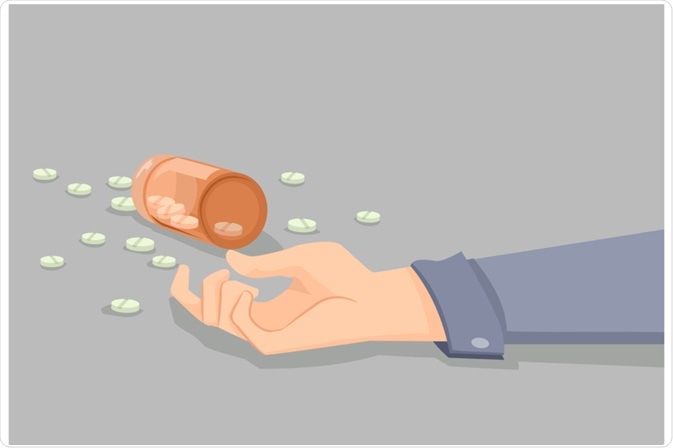Olanzapine represents a second-generation atypical antipsychotic agent that is currently approved for the treatment of psychotic disorders, schizophrenia, schizoaffective disorders, mania, and other conditions with psychotic components. As the usage of such atypical antipsychotic medications in adults and children increases, the number of overdoses and unintentional ingestions will continue to grow.

Image Credit: Lorelyn Medina / Shutterstock.com
The adverse consequences of olanzapine overdose are compounded in psychiatric populations because of numerous, yet seldom adequately diagnosed and treated, physical illnesses, intricate polypharmacy with high doses of psychotropic drugs, and delayed or absent interventions.
Olanzapine overdose
Olanzapine has a high volume of distribution that is estimated to be between 10-20 liters per kilogram. Moreover, the rate of metabolism for olanzapine can vary up to 20-fold among individuals. Due to the extensive first-pass metabolism of up to 40% for this drug, large overdoses result in nonlinear pharmacokinetics that leads to striking increases in blood concentrations.
The most common symptoms that arise as a result of olanzapine overdose include central nervous system (CNS) depression with somnolence, blurred vision, low blood pressure, respiratory depression, extrapyramidal and anticholinergic effects, as well as exceptionally high fever.
Some studies point to the possibility of olanzapine overdose mimicking opiate intoxication. Therefore, olanzapine should be added to opioid and α2-adrenergic agonist intoxication in the differential diagnosis of a patient with depressed mental status and miosis, which is the excessive constriction of the pupil of the eye.
Deaths attributed to probable cardiac toxicity have been continuously reported from olanzapine overdose. Postmortem olanzapine blood concentrations may not represent true levels before or during death, hence they should be interpreted with caution. A more reliable indicator of overdose is the drug concentration in the liver.
It is postulated that the most probable mechanism of death in an overdose of olanzapine involves cardiac toxicity at the cellular membrane level, albeit the exact mechanism remains elusive. Such development would be consistent with the inferred nature and rapidity of the terminal event.
Therapeutic drug monitoring
Therapeutic drug monitoring is an efficient way to assure the quality and individualization of drug treatments. Older types of antiepileptic drugs, as well as both tricyclic antidepressants and lithium, have a well-documented concentration-effect relationship, which is also known as a therapeutic window.
Still, the evidence for a concentration-effect relationship is not as extensive for olanzapine, despite the fact that it exhibits a curvilinear concentration relationship of clinical effects and potential adverse activities. The interdisciplinary guidelines for therapeutic drug monitoring in psychiatry suggest that serum concentration of olanzapine should be carefully monitored. Moreover, the recommended therapeutic range for olanzapine should be between 20 and 80 ng/ml.
Therapeutic drug monitoring also has value for preventing overdosing that can arise as a result of changes in treatment or environment of patients. For example, studies have shown that serious side effects and intoxications due to olanzapine therapy can occur after smoking cessation. Increased risk of serious ventricular arrhythmias and sudden cardiac death is also dose-dependent.
References
Further Reading